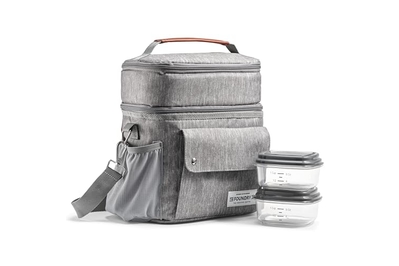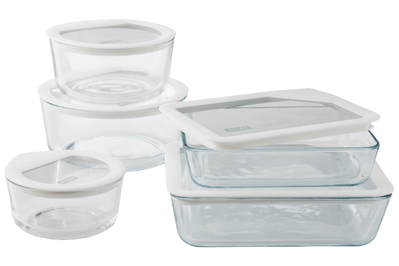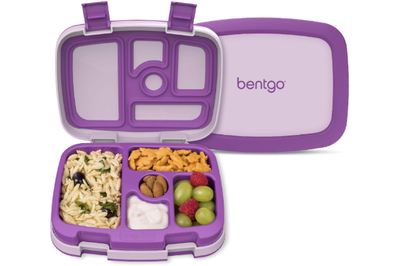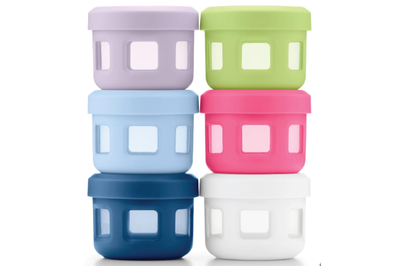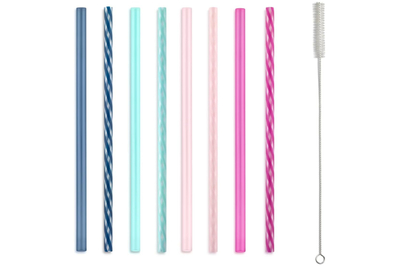
Depending on the severity of your reaction, you may feel more comfortable using your own cookware—especially pots, pans, and colanders. Cooking your food ahead of time and bringing it in reusable containers or picking up a prepared favorite is a great way to enjoy a hot meal you know will keep you feeling good.
Any time we leave the house for the day, we have to plan every meal and snack that my kids eat in advance. That means we often bring premade food with us. This felt daunting at first, but now it’s just part of our routine. Having dependable, portable storage and serving containers makes a big difference.
Lunch boxes and coolers
Having a travel cooler is essential to keep food safe to eat. A large, insulated lunch box that is compact yet spacious enough to hold a day’s worth of meals and snacks works well, too. My family has brought the Fit & Fresh Foundry Lunch Bag on every trip for more than a year. It’s been sledding in Québec City, to a wedding in California, and to the beach in North Carolina. I love that its main compartment can fit multiple bentos and drinks and that it has a separate, smaller-but-still-roomy compartment. We use the smaller compartment for foods that we want to be able to access without digging through the entire cooler.
As an alternative, the Carhartt Insulated 12 Can Two Compartment Lunch Cooler is a pick in our lunch box guide and has a comparable design. It performed well in our insulation tests, and it’s highly rated on Amazon for its durability.
For longer trips where we may not have access to gluten-free groceries, we bring everything we need in our larger cooler and pack the Foundry bag each day. If you’re torn on what type of cooler would work best for your lifestyle, we have hard, soft, and disposable recommendations.
Packable food containers

Upgrade pick
Top pick
What do we put in our cooler, you ask? Any time we will need to reheat our food, we pack meals in glass storage containers that can be used in the microwave without their lids, like the Pyrex Simply Store containers. Our Pyrex containers are extremely well traveled, and though the glass itself has remained intact, the lids have cracked over the years. It is possible to buy replacement lids, though. Alternatively, Pyrex’s Ultimate line (a forthcoming upgrade pick in our guide to food storage containers) uses the same containers but with glass and silicone lids. They seal better (though may leak if jostled) and may last longer.
For day trips or smaller outings that don’t require hot food, I pack meals and snacks in bento boxes. We have a few kinds, but we return to our Bentgo Kids Lunch Boxes most often. My kids can open them themselves, and they have the food separation and general cute factor of a bento box without having multiple containers to keep track of.
Condiment and spice containers

Whenever we go to events, I try to make sure my kids have food that is as exciting as whatever other kids have. I keep some treats in the freezer for birthday parties, and for other celebrations, I plan out whatever fun foods my kids may need a substitution for. Say an ice cream shop offers tons of amazing flavors and toppings, but the only option that’s safe is plain vanilla soft serve. Guess who has gluten-free sprinkles in her purse? Or if we’re meeting friends at a restaurant that has questionable homemade condiments, I have ketchup in here too.
I love the Ello Reusable Condiment Containers because I can carry everything from spices to sauces without worrying about them leaking in my bag. They are big enough to hold multiple portions of a condiment or topping but take up very little room. Condiments and spice blends can be a sneaky source of gluten and other allergens, either through their own ingredients or from cross contact through double dipping. So I bring these containers everywhere from restaurants to relatives’ houses (though cleaned out mini jam jars could work just as well).
For larger items, like cupcakes, I prefer less-expensive food storage containers in case they break or get lost. Tip: Try to hand the treat to the host discreetly, give them a brief explanation about cross contact, and ask if they wouldn’t mind serving it on the same fun plates as the regular birthday cake (or cupcakes or cookies) so your kid feels as included as possible.
Reusable straws
I have always liked to bring reusable straws with me to avoid waste, but this habit has been unexpectedly important now that we are a celiac family. Though I love the general concept of finding a better alternative to single-use plastic than mushy paper straws, some are made with wheat, which are not safe for my kids to use.
Our guide to reusable straws has metal and silicone recommendations for adults and kids alike. I also like the Ello Impact Reusable Plastic Straws. They’re straight and wide, so they’re easy to clean, and they feel more kid-friendly than metal straws—especially if your kids gnaw on straws like mine do. We’ve tried silicone straws in the past, but I found that they held onto smells and flavors. For storage, I use pouches from Baggu that are machine-washable and perfectly straw-sized.
When we became a celiac family, navigating cross contact and planning for every meal and snack felt incredibly daunting. I can safely say that we are now able to fully enjoy the social aspects of mealtime, even in the presence of our unsafe foods. It was simply a matter of finding the right gear to keep us organized and gaining the confidence to carry ketchup in my purse.
This article was edited by Marguerite Preston and Katie Okamoto.


